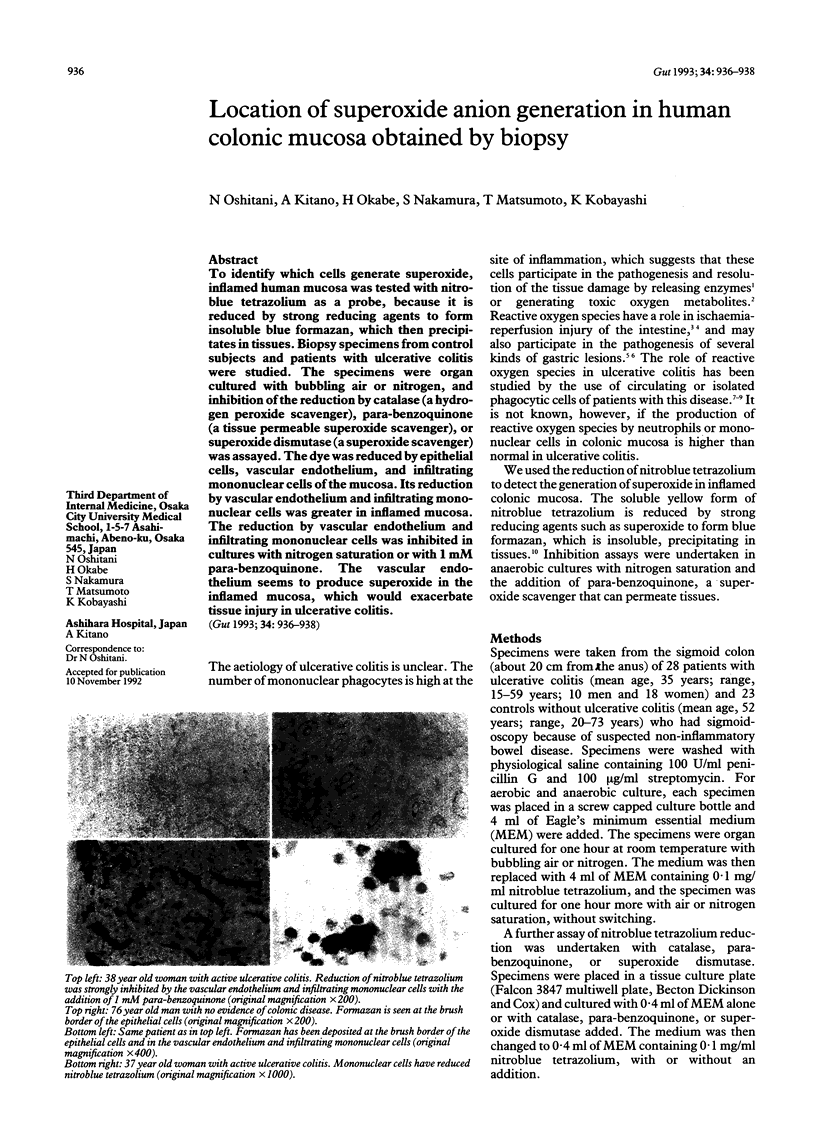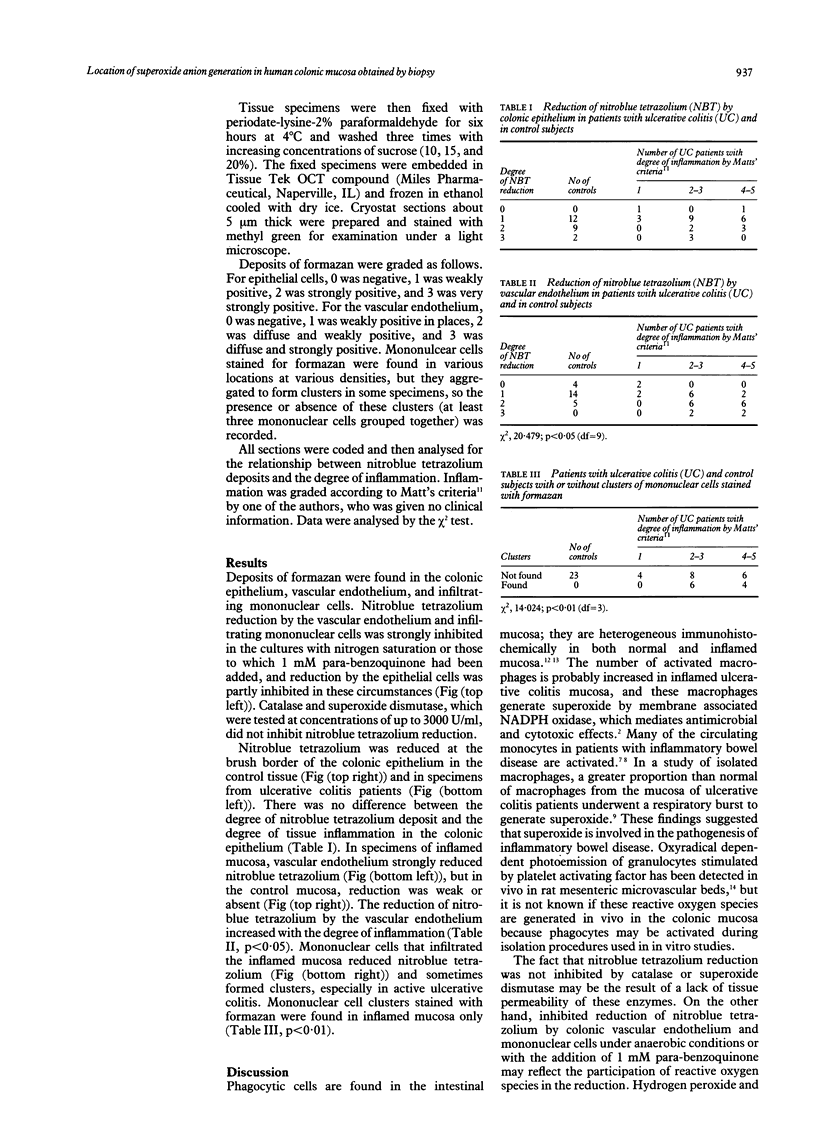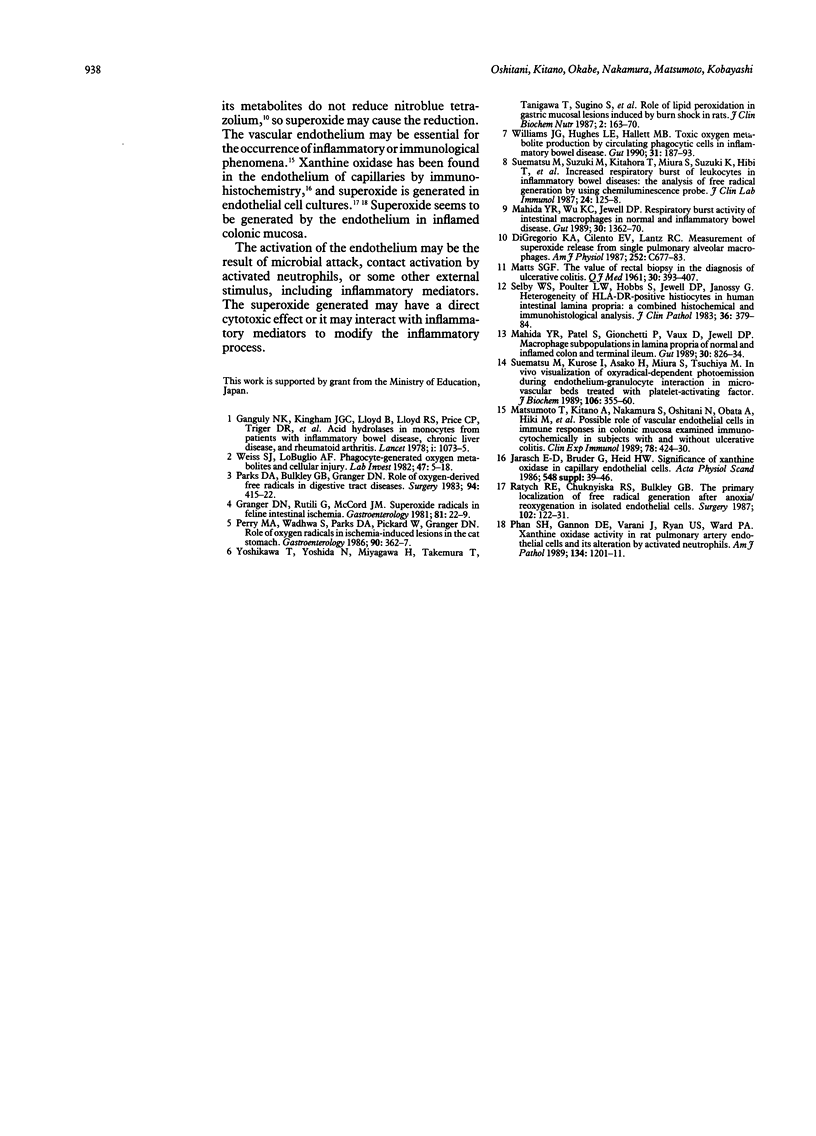Abstract
To identify which cells generate superoxide, inflamed human mucosa was tested with nitro-blue tetrazolium as a probe, because it is reduced by strong reducing agents to form insoluble blue formazan, which then precipitates in tissues. Biopsy specimens from control subjects and patients with ulcerative colitis were studied. The specimens were organ cultured with bubbling air or nitrogen, and inhibition of the reduction by catalase (a hydrogen peroxide scavenger), para-benzoquinone (a tissue permeable superoxide scavenger), or superoxide dismutase (a superoxide scavenger) was assayed. The dye was reduced by epithelial cells, vascular endothelium, and infiltrating mononuclear cells of the mucosa. Its reduction by vascular endothelium and infiltrating mononuclear cells was greater in inflamed mucosa. The reduction by vascular endothelium and infiltrating mononuclear cells was inhibited in cultures with nitrogen saturation or with 1 mM para-benzoquinone. The vascular endothelium seems to produce superoxide in the inflamed mucosa, which would exacerbate tissue injury in ulcerative colitis.
Full text
PDF


Images in this article
Selected References
These references are in PubMed. This may not be the complete list of references from this article.
- DiGregorio K. A., Cilento E. V., Lantz R. C. Measurement of superoxide release from single pulmonary alveolar macrophages. Am J Physiol. 1987 Jun;252(6 Pt 1):C677–C683. doi: 10.1152/ajpcell.1987.252.6.C677. [DOI] [PubMed] [Google Scholar]
- Ganguly N. K., Kingham J. G., Lloyd B., Lloyd R. S., Price C. P., Triger D. R., Wright R. Acid hydrolases in monocytes from patients with inflammatory bowel disease, chronic liver disease, and rheumatoid arthritis. Lancet. 1978 May 20;1(8073):1073–1075. doi: 10.1016/s0140-6736(78)90917-0. [DOI] [PubMed] [Google Scholar]
- Granger D. N., Rutili G., McCord J. M. Superoxide radicals in feline intestinal ischemia. Gastroenterology. 1981 Jul;81(1):22–29. [PubMed] [Google Scholar]
- Jarasch E. D., Bruder G., Heid H. W. Significance of xanthine oxidase in capillary endothelial cells. Acta Physiol Scand Suppl. 1986;548:39–46. [PubMed] [Google Scholar]
- MATTS S. G. The value of rectal biopsy in the diagnosis of ulcerative colitis. Q J Med. 1961 Oct;30:393–407. [PubMed] [Google Scholar]
- Mahida Y. R., Patel S., Gionchetti P., Vaux D., Jewell D. P. Macrophage subpopulations in lamina propria of normal and inflamed colon and terminal ileum. Gut. 1989 Jun;30(6):826–834. doi: 10.1136/gut.30.6.826. [DOI] [PMC free article] [PubMed] [Google Scholar]
- Mahida Y. R., Wu K. C., Jewell D. P. Respiratory burst activity of intestinal macrophages in normal and inflammatory bowel disease. Gut. 1989 Oct;30(10):1362–1370. doi: 10.1136/gut.30.10.1362. [DOI] [PMC free article] [PubMed] [Google Scholar]
- Matsumoto T., Kitano A., Nakamura S., Oshitani N., Obata A., Hiki M., Hashimura H., Okawa K., Kobayashi K., Nagura H. Possible role of vascular endothelial cells in immune responses in colonic mucosa examined immunocytochemically in subjects with and without ulcerative colitis. Clin Exp Immunol. 1989 Dec;78(3):424–430. [PMC free article] [PubMed] [Google Scholar]
- Parks D. A., Bulkley G. B., Granger D. N. Role of oxygen-derived free radicals in digestive tract diseases. Surgery. 1983 Sep;94(3):415–422. [PubMed] [Google Scholar]
- Perry M. A., Wadhwa S., Parks D. A., Pickard W., Granger D. N. Role of oxygen radicals in ischemia-induced lesions in the cat stomach. Gastroenterology. 1986 Feb;90(2):362–367. doi: 10.1016/0016-5085(86)90933-9. [DOI] [PubMed] [Google Scholar]
- Phan S. H., Gannon D. E., Varani J., Ryan U. S., Ward P. A. Xanthine oxidase activity in rat pulmonary artery endothelial cells and its alteration by activated neutrophils. Am J Pathol. 1989 Jun;134(6):1201–1211. [PMC free article] [PubMed] [Google Scholar]
- Ratych R. E., Chuknyiska R. S., Bulkley G. B. The primary localization of free radical generation after anoxia/reoxygenation in isolated endothelial cells. Surgery. 1987 Aug;102(2):122–131. [PubMed] [Google Scholar]
- Selby W. S., Poulter L. W., Hobbs S., Jewell D. P., Janossy G. Heterogeneity of HLA-DR-positive histiocytes in human intestinal lamina propria: a combined histochemical and immunohistological analysis. J Clin Pathol. 1983 Apr;36(4):379–384. doi: 10.1136/jcp.36.4.379. [DOI] [PMC free article] [PubMed] [Google Scholar]
- Suematsu M., Kurose I., Asako H., Miura S., Tsuchiya M. In vivo visualization of oxyradical-dependent photoemission during endothelium-granulocyte interaction in microvascular beds treated with platelet-activating factor. J Biochem. 1989 Aug;106(2):355–360. doi: 10.1093/oxfordjournals.jbchem.a122857. [DOI] [PubMed] [Google Scholar]
- Suematsu M., Suzuki M., Kitahora T., Miura S., Suzuki K., Hibi T., Watanabe M., Nagata H., Asakura H., Tsuchiya M. Increased respiratory burst of leukocytes in inflammatory bowel diseases--the analysis of free radical generation by using chemiluminescence probe. J Clin Lab Immunol. 1987 Nov;24(3):125–128. [PubMed] [Google Scholar]
- Weiss S. J., LoBuglio A. F. Phagocyte-generated oxygen metabolites and cellular injury. Lab Invest. 1982 Jul;47(1):5–18. [PubMed] [Google Scholar]
- Williams J. G., Hughes L. E., Hallett M. B. Toxic oxygen metabolite production by circulating phagocytic cells in inflammatory bowel disease. Gut. 1990 Feb;31(2):187–193. doi: 10.1136/gut.31.2.187. [DOI] [PMC free article] [PubMed] [Google Scholar]



